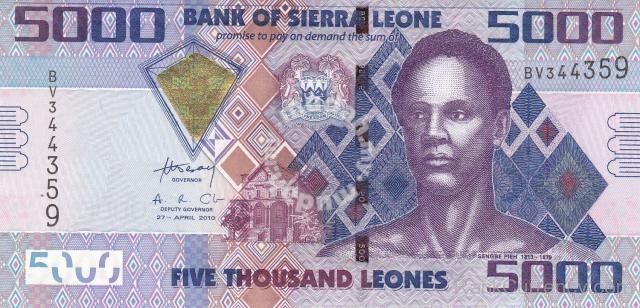
State of our Currency*
By Jiwoh Abdulai
The depreciation of the Leone over the past few weeks is a growing concern to consumers, firms and policy makers. Over the past year we’ve seen a 20% decline in the Leone relative to the U.S. Dollar. Currency depreciation is not necessarily a bad thing, but the current structure of the Sierra Leone economy not only makes it difficult for the country to enjoy the benefits but also increases the costs to consumers. As policy makers worry about the undesirable effects of this decline on consumer prices and interest rates, they should also examine the possible root causes and take steps that would bring relative stability to the currency. Our policy makers should not only focus on imbalances in the current account, but they should also explore capital account imbalances, if business community is reducing its exposure to the Leone because of reduced confidence in the economy. This business exposure reduction can be done by transferring capital abroad or converting it to foreign currency (forex) to secure the value of the capital. Prolonged volatility in the currency could trigger a balance of payments crisis that will undermine the fragile confidence in the economy.
Countries can sometimes benefit from currency depreciation. For industrialized countries, currency depreciation makes local goods and services cheaper in domestic and foreign markets, compared to foreign goods and services. In the domestic market, citizens are likely to substitute locally produced goods for imports, as imported goods and services become more expensive. Exports also become cheaper in foreign markets. Both effects increase demand for locally produced goods. As firms ramp up production to meet the increased demand, they would hire more workers, thereby increasing employment and output. There might be a slight uptick in the consumer price index, as some of the imported goods or services do not have readily available substitutes, but this increase will be dampened by the availability of locally made substitutes.
In Sierra Leone the dearth of locally produced goods that compete effectively with most of the imported goods, significantly reduces the capacity of the economy to benefit from currency depreciation. It also means that the pass-through effect of currency depreciation on the consumer basket of goods is more severe. Prices rise for most of the goods (rice, onions, canned tomatoes, flour, sugar, fish bought from foreign operated trawlers etc.) consumed on a daily basis. This increase in cost of living has the most impact on the vulnerable members of society. The cost of goods sold (in Leones) increases for fuel marketers and usually creates challenges for policy makers. They can risk public outrage and allow the marketers to pass through those costs to consumers or the government can absorb the increased costs and pay the marketers subsidies to keep fuel prices stable and lower than they would be, if consumers paid the full cost at the pump. The latter option usually drains resources from the budget and disproportionately benefits heavy users of fuel who are usually the more affluent in society. However if the costs are passed through to the pump price, there’s a secondary effect on transportation costs. Those costs are then passed on to domestically produced goods including basic commodities sold in local markets.
Currency depreciation is not only a major factor in domestic inflation but also factors into inflation expectations. Monetary Policy makers usually set policy rates slightly higher than inflation expectations so that real rates (the difference between interest rates and expected inflation rates, which reflect the real yield to lenders of funds) are positive. Financial institutions use policy rates as benchmarks when submitting bids at treasury auctions or lending to firms and consumers, so high policy rates increase the cost of borrowing for the government, businesses and consumers.
Foreign exchange rate movements are driven by supply and demand of one currency relative to another. For example, at any given price, if the supply of USD exceeds demand, the dollar rate drops. The term you would hear from the “dollar boys” is “dollar done boku”. If demand exceeds supply the rate goes up. Dollar boys would say “Dollar don scarce”. To curb a currency decline, policy makers either pursue policies that increase supply of forex, decrease demand for forex or a combination of both. To understand the options available to policy makers trying to address the depreciation of the Leone, we need to understand the factors that drive supply and demand for forex.
Supply and demand for forex is driven by transactions between Sierra Leonean individuals, firms and government entities, and individuals, firms and government bodies outside the country. These transactions consist of imports and exports of goods, services and capital, repatriation of income (from foreign countries by Sierra Leonean entities and from Sierra Leone to foreign owned entities) and current transfers like remittances and grants from foreign donors.
In normal times, the main transactions affecting demand for forex are imports, repatriation of income by foreign entities operating in Sierra Leone, increases in forex reserves by the central bank. In today’s environment, anecdotal evidence suggests that there might be a slight reduction in imports of basic goods and services. Most business people complain that “money nor dae flow”. This affects the turnover of importers who would then slow the rate (or volume) at which they import and decrease their demand for forex. There isn’t much policy makers can do to reduce demand further. However, in the short term, policy makers can review public sector demand for forex. This demand comes from procurement of imported goods and foreign services, including foreign travel. When “money nor dae flow”, foreign companies that cater to the domestic market are also affected. This will affect turnover and income they repatriate to their home countries and reduce their demand for forex.
Exports, foreign investments into Sierra Leone and current transfers account for most of the transactions that affect the supply of forex. Increasing exports can increase supply of forex, but doing so in the current environment can be difficult. Increasing exports in our main agricultural products requires investments to increase output and it takes years to realize the increased output. Recent foreign direct investments in large agricultural projects are positive developments that should result in a slight increase in supply in the short run as investors bring in forex to set up operations. In the medium term, these investments will either significantly increase supply of forex by increasing exports or reduce the demand for forex by producing goods that can be substituted for imports. Either way, they would reduce pressure on the Leone. Similarly, increasing exports in the mining sector takes time and investment. That investment depends on global prices and demand for mineral commodities. While mining activity for some commodities continues to be stable, the iron ore sector has not recovered from its recent slump. The government’s push to attract investors in this sector should positively affect the supply of forex in the medium term. Privatization of state assets to foreign investors can also increase supply of forex as investors would bring in forex to complete those transactions. However, privatizations should focus on assets for which the government can extract value.
Forex supply could be negatively affected if exporters drastically reduce the volume of forex brought back into the country, because of low investor confidence. That’s a form of capital flight that gets around capital controls. In times of economic stress, capital flight can disrupt the forex market and cause sharp movements in the forex rates. These movements can be amplified if there is a rush to convert the domestic currency into forex. In such times, policy measures should focus on restoring confidence in the currency and the economy.
Increased exports of services will increase supply of forex in the medium term. Tourism is perhaps the most lucrative sector as tourists bring in forex to pay for goods and services locally. The government should continue its efforts to rebrand Sierra Leone and intensify collaborations with domestic and foreign industry experts to boost tourism. There is also enormous potential for outsourcing. Fiber optic connectivity makes it possible for Sierra Leone to use its GMT time zone advantage to provide outsourced back office services to foreign firms across operating multiple time zones. Payments for these services will be in forex.
Foreign financial investments that come in the form of loans to the government and current transfers that are grants to the government are the other transactions that can increase supply of forex. These usually come in the form of “macroeconomic stability” packages from multilateral donor partners like the IMF and the World Bank Group. For countries like Sierra Leone that do not have access to global capital markets, this source of forex is usually the last resort. It usually requires negotiation with donor partners at times when the country has little leverage. As a result, the timing of the disbursement(s) is out of the control of our policy makers.
The recent decline in the currency is a concern for Sierra Leoneans because the short term options policy makers have for tackling it are limited. In the short term, policy makers should focus on measures that will restore confidence in the currency and the economy, while taking actions to reduce public demand for forex, bring forward capital injection or current transfers from donor partners. They should also explore efficient privatization of state assets. In the medium term, policy makers should continue focus on expansion of economic activity in sectors that will increase supply for forex through exports or decrease demand for forex through import substitution. In addition, policy makers should consider creation of a forex stabilization fund that will enable them to effectively intervene in the forex markets in the future.
MATHEMATICS QUESTION FOR THE BIO GOVERNMENT.
1.PREZ KOROMA MET THE EXCHANGE RATE AT LE3,500/$1 AND TOOK 11YRS TO REACH LE7,500/$1.
IN JUST 11 MONTHS OF BIO ADMINISTRATION, OUR EXCHANGE RATE IS NOW LE10,000/$1. WHAT WILL BE THE EXPECTED EXCHANGE RATE IN FIVE YEARS OF THE BIO RULE? ALSO SHOW THE PERCENTAGE INCREASE IN YOU ROUGH WORK.
2. PETROL WAS MET LE4,500/L AND NOW LE7,000/L, HOW MUCH IS THE EXPECTED PRICE IN THE NEXT FIVE YEARS?
3. HOW IS THE SKYROCKETING INFLATION AFFECTED LOCAL INVESTORS AND STANDARD OF LIVING OF THE PEOPLE?



